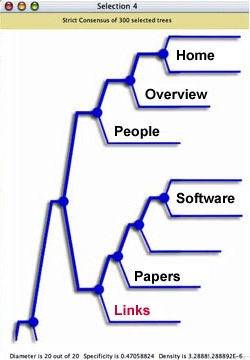 Tree Set Viz : Visualizing
Tree Space
Tree Set Viz : Visualizing
Tree Space 
|
| Phylogenetic trees provide valuable information about evolutionary
relationships and are powerful tools used in many areas of biology. Comprehensive
phylogenies of pathogens allow researchers to predict evolution aiding
in the development of vaccines. Additionally, phylogenies can be effectively
applied to analyses of character evolution, gene expression, and to many
areas of conservation biology.
There are several methods available for inferring phylogenetic trees based on many different types of data. Systematitists can collect molecular data, such as nucleotide or amino acids, or they can use morphological or behavioral information to construct an evolutionary tree. Some methods, however, can yeild a large number of trees that the systematist must then have to summarize. A set of trees may include several optimal or near-optimal parsimony trees or the set of trees may be the trees sampled during a Bayesian analysis. The Tree Set Visualization program is capable of summarizing large
sets of phylogenetic trees. This program depicts a "tree space"
using multi-dimensional scaling based on tree-to-tree distance metrics.
Visualizing sets of trees in such a way can yield more information about
the trees that may otherwise be lost using more conventional methods
for condensing large sets of trees. |
|

|
This research project is supported by a grant from the National Science Foundation, NSF-ITR 0121651/0121682: "Collaborative Research: Exploring the Tree of Life." |